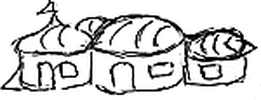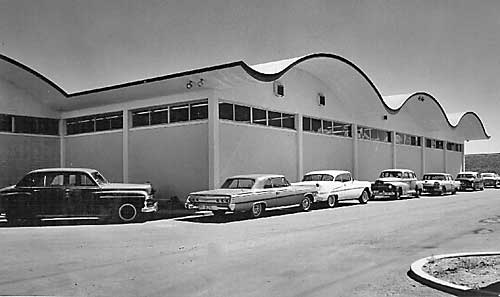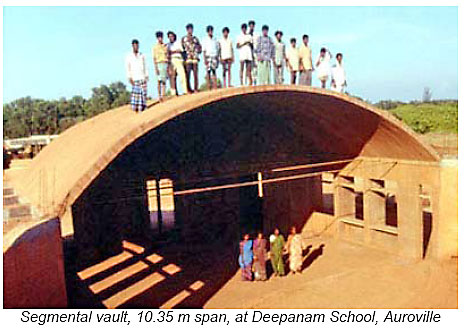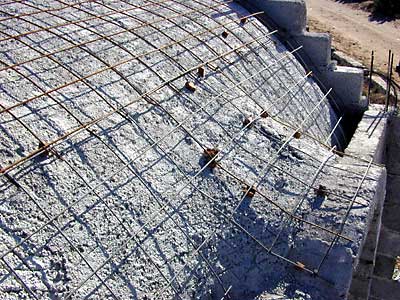INTRODUCTION TO CONCRETE VAULTS
|
Vaulted Roofs
I pass over 200 masonry vaults on the 25 minute drive between my place and town (San Miguel). We have a local tradition of vaulted roofs here in central Mexico. The older vaults (200 year +) that are still standing were all well constructed but many of the newer (100 year old) vaults were poorly built. With these vaults it is basically the shape of the roof which is the key to it's long life. It sometimes hard to believe that these roofs can stand so long without maintenance. I feel that my vaults are well built with modern materials and they should last for at least 400 years--and that buoys my enthusiasm. Notes on Terminology: Vault, Shell, Thin Shell, Roof Membrane - all the same thing BV - Barrel Vault, form that results from cutting a barrel (cylinder) in half, long ways #66WW - Welded Wire mesh (driveway mesh) For example: #6,6,10,10 WW mesh is 6" X6" X 10 gauge X 10 ga. Don't worry #6666WW (66WW) is not the devil's mesh but actually quite wonderful stuff. Feet and Meters - Here in Mexico we are bilingual. We buy plumbing pipe in inches (diameter) and then cut it into meters. I try to convert everything, but it gets tiresome. Please bear with me. |
Concrete Vaults ---the Wave of the Future
Types of Vaults
There are many types of possible vault configurations. For now let's keep it simple and look at three different types of vaults, barrel vaults, domes and semi-dome vaults.
There are many types of possible vault configurations. For now let's keep it simple and look at three different types of vaults, barrel vaults, domes and semi-dome vaults.
|
THESE LINKS ARE A GOOD PLACE TO START
Start with these links to get a good general introduction to roof vaults
Below are links to other pages on this site:
|
|
STEVE'S RULES OF THUMB FOR SMALL VAULTS
These rules represent my current thinking. Most are widely accepted and some could be my personal opinion. My opinions are open to change. Please send me comments. ROOM SIZED VAULTS ARE BEST Vaulted roofs should be room sized and vary in height and complexity. Small vaults (under 15 ft / 4.5M) are MUCH easier to build than larger vaults. Vaults that span over 6M (20 ft) wide are much more structurally demanding, require more engineering and cost more per sq ft of floor space. Huge round domes work well only for special spaces and are almost never recommended. Simple and complex vaults work well together in the same house. Movable formwork helps make complex more economical. Keep vaults small and build smaller and smarter rooms. |
|
DEAD LOADS IN VAULTS FOLLOW A CATENARY SHAPE
Arches and vaults can have various shapes and sizes, but the line of thrust for a uniform dead load always follows the shape of an inverted catenary curve. Ideally the reinforcing follows this line of thrust all the way to the foundation. This can be done with buttresses or ribs.(see Vaults A and B page and see the catenary page.) Standard practice would be reinforced concrete columns, reinforced side and end beams, and shear walls under these beams. Seismic and wind loads don't necessarily follow this curve and further necessitate shear walls. For information on building un-reinforced vaults see http://www.earth-auroville.com/index.php?nav=menu&pg=vault&id1=2 See also Catenary Vault in Mexico. |
Def: catenary -
Etymology:New Latin catenaria, from Latin, feminine of catenarius of a chain, from catena Date:1788 1 : the curve assumed by a cord of uniform density and cross section that is perfectly flexible but not capable of being stretched and that hangs freely from two fixed points 2 : something in the form of a catenary Merriam-Webster's 11th Collegiate Dictionary |
|
BUILD VAULTS IN GROUPS
Design the roof systems so that a series of small vaults lean upon one another to reduce the need for structural support inside the building. Structurally, the ideal configuration will have higher, larger, vaults in the center of the building and smaller,lower vaults near the exterior edges. (See "A Pattern Language", # 206 "Efficient Structure" ,# 209 Roof layout.) Consider the use of buttresses or ribs to reinforce the outside perimeter.(see Vaults A and B page). |
|
HEIGHT OF VAULTS
"A Pattern Language" says "build floor and ceilings in the form of elliptical vaults which rise between 13 and 20% of the shorter span" These vaults are actually quite low (a half circle is 50%) and most of the barrel vaults I build are typically 30-35%. Their vaults are modified domes so they can have a lower profile. For some roof calculations you need to look at the roof as a section of a circle. A 90 degree section is about a 22% rise and a 120 degree section is about a 30% rise. Another way to look at the height question -- according to "A Pattern Language" -- "vaults start at 6 feet 6 inches and rise 1/5 the diameter of the room". Once again, my vaults typically start lower and rise about 1/4 the diameter. |
|
REUSABLE, MOVABLE FORMWORK
Formwork and the labor involved in setting it up and taking it down can cost as much as the concrete and iron. Reusable formwork saves money. Complex shaped vaults can easily be built in series with movable formwork. I dream of inexpensive "units" with beautiful roofs. The basic idea is you use two layers of welded wire. The first, lower, layer of welded wire is FORMWORK. It is removed and reused. The second upper layer is placed inside the roof pour for reinforcing. Once you understand this you will "get it" The idea here is an inexpensive, reusable formwork. Three guys (gals) can set the formwork for a 4M X 5M vault in 2 hours flat -- the second one,anyway. WOW!! If you want an inexpensive vaulted/domed roof --- my system could give you some ideas. Movable Formwork Page Underground BV with movable forms roof forming |
|
|
|
|
|
ROOF COSTS EQUAL 20%
A sealed, concrete vault roof should cost between 15- 20% of the total square feet - finished price-- low income and high end. With very little maintenance, this roof should last for at least 200-400 years. A simple BV will cost $5-10 / square foot living space. Complicated vaults $15-30. Figuring out the actual cost is, of course, quite complicated. For more ideas, see Roof Costs page. |
|
REINFORCING VAULTS
Small vaults need very little reinforcing. If a concrete roof is in a vaulted shape**, for the curved membrane, use: Two layers of #66WW (6" X 6 gauge.,welded wire -- driveway mesh) in a 2 1/2" (7cm) pour of 3,500 psi (220 Kg/c2) concrete. This will cover a good sized vault (4.5 M X 6 M) while resisting a moderate-sized earthquake. Almost all BV and most domes need side and edge beams and shear walls to transfer lateral loads and these are a bit harder to figure. ** Rise in vault is equal to 15-30% of shorter span For more information go to reinforcing needed for small concrete vaults. See also Vaults A and B |
|
|
ROOF THICKNESS / R-VALUE / INSULATING VAULTS
The roof membrane will be thinner when using hard concrete (3,500 psi) than when using light weight. Typically 2 1/2" thick for hard concrete and 4-6" of light weight in mild climates. Both are adequate for the first floor vault that will be filled on the sides and have another floor above. Hard concrete has almost no R-value and needs to be insulated. With light weight concrete it all depends upon the aggregate you use. For a fluffy pour with my volcanic aggregate, I claim R-2 per inch, but I don't know for sure. So 6" is about R-12 and that's about all I need here. Light weight mixes using foam beads or vermiculite will vary greatly. Properly used solar gain affects R values and R40 ceilings may not be necessary with this material even in cold sites. If you find you want more insulation, mix and place another 6"of light weight, next year. Hard concrete has almost no R-value and shells built with it, need insulation in most climates. In the USA, I have used rigid insulation between two concrete shells to address the insulation issue. This is easy with barrel vaults and doable with domes. Other options include spraying the exterior surface with foam or gluing rigid sheets and then covering this with fibered mortar or EPDM membrane. Light weight concrete works well for insulation in moderate climates. For more ideas on insulating vaults, see construction. |
|
SEALING THE ROOF / SPALLING
Water can enter cracks in a concrete roof and freeze, thereby spalling (expelling cone-shaped pieces) the concrete and exposing the metal reinforcing. A bad situation. Some engineers will specify extra concrete on top of a shell to help avoid spalling and give more protection to the iron. Spalling is best prevented by a layer of lath or fibered concrete near the exterior surface OR by a bomb-proof sealing product/membrane. Here, in this part of Mexico we don't have much freezing rain so I try to not seal vaulted roofs-- just a sponge finish on top of a fiber coat and then seal the initial cracks and it's good for several years. One of my crazy ideas is that it is better in this climate if the roof can breathe-- if it isn't completely sealed. Roman concrete lasted so long because it wasn't sealed. Sealed concrete is never completely sealed and if moisture enters the 2% of cracks it can't escape and becomes trapped inside because the exterior surface is 98% sealed. See Cracks in Vaults (end of Construction page). See also Vapor Barriers |
|
FIBERS
Fibers work well for crack control and some types of fibers (PVA,for example) add considerable strength to the mix. I like PVA (poly vinyl alcohol) fibers added to the concrete @ .2-.5% by weight . They cost about $4 /lb. Polyethylene fibers mix well but don't add as much strength. Poly propylene fibers don't mix well and add no strength. PVA fibers:For more information, look at http://nycon.com/pva-fibers/ |
|
400 YEAR GUARANTEE / DISPOSABLE HOUSING
With or present technology we can cost effectively build housing that will last for 400 years-- OR we can continue to look at housing as disposable-- like they do in some of the wealthier countries. STEVE'S 200 YEAR QUESTION Is your house good for another 200 years? --- If not, perhaps it was a mistake. 400 YEAR GUARANTEE/ 50 YEAR REMODEL OK, now you have finished building your dream home. It is going to last basically forever (400 years) - what's next? Well in about 50 years, somebody will want to change the doorway openings to make a dress store, sheep shed, back bed room, or new kitchen. Some remodeling is likely in the next 400 years-- so, how does the next guy do it? |









































